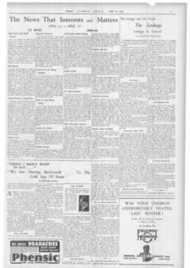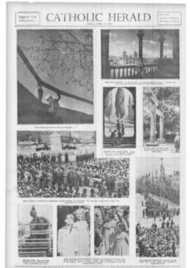Page 1, 30th April 1937
Page 1

Report an error
Noticed an error on this page?If you've noticed an error in this article please click here to report it.
Tags
Share
Related articles
Destruction Of Guernica
What Happened At Amorebieta Set Alight Before Evacuation
Air Warfare In Spain
Exaggerated Figures In British Press
Open Town Bombing Regular Practice Of Reds
Official Salamanca enial
REPORTS TRACED TO SINGLE SOURCE
Germans ? Nationalists ?
Incendiaries ?
WHAT IS THE REAL TRUTH ABOUT THE FATE OF GUERN ICA ?
A storm of indignation against the behaviour of the Nationalists who were reported to have allowed a fleet of German aeroplanes to destroy the ancient Basque capital and kill many of its inhabitants has arisen. General Franco has issued a statement denying that Nationalist aeroplanes bombed Guernica with incendiary bombs.
" We assert," he said, " that our aviation has not bombed Guernica because it is not a military objective.
" Those who set fire to Iron and Eibar are the same as those who are now trying to impute that we set fire to Guernica."
German authorities likewise deny that their aeroplanes were responsible.
A detailed analysis of the reports in the English press makes it clear that they are all attributable to one source, the news, no doubt, given out in Bilbao. Each paper has made it appear as though its story were a private and exclusive version Though special correspondents in later reports describe seeing bomb-holes and being chased by retreating German air-craft these same correspondents had implied in earlier reports that they did not reach Guernica until ten hours after the bombardment.
The Catholic herald shares General Franco's indignation at the thought of the wanton destruction of an open town without warning, but until the facts are known it reserves its comments on a tragedy whose meaning is as yet unascertainable.
There is clear contrast between the immediate universal indignation in the British Press at the reported destruction without warning of an open town by the Nationalists and its silence in the past at precisely the same behaviour on the part of the Reds.
In an interview with Captain McCullagh, the well-known internatioVafjournalist just bark fronz Spain, a Catholic Herald reporter describes Captain McCullagh's surprise at the space given to one incident, the like of which he has himself more than once witnessed in Talavera, Merida, Badajoz and elsewhere. In these cases, however, it was the Reds who did the bombing.
The complete falsity of Spanish Government reports accepted by the world Press has been proved more than once and instances are given below. .
Experience in regard to news from Spain makes it essential that this appalling story should be carefully examined and investigated before it becomes the basis of a wave of anti-Nationalist indignation similar to that which followed the alleged massacres in Badajoz. In regard to the latter it has at least been shown that the original story has been greatly exaggerated and it is to-day held by serious journalists who have examined the evidence on the spot to have been entirely invented.
The bombardment has been officially denied by Salamanca, the destruction of Guernica being attributed to Basque incendiarisrn for propaganda purposes, but zertain points about the news reports inade it immediately evident that further investigation was needed before they could be accepted.
Traceable To One Source In the first place it is evident that all the accounts are traceable to the same source, dated from Bilbao.
Even the long account printed in The Times from its Special Correspondent and headed "Eye-Witness's Account " is up to a point exactly the same as the story in all the other newspapers. The Times Special Correspondent, for example, notes that " a large herd of sheep being brought into the market was also wiped out," Mr. Christopher Holme, the Daily Herald correspondent, whose message is also signed Reuter. notes "even flocks of sheep were machine-gunned," This is a small example of a strange similarity running right through all the accounts. In each the same relative emphasis to each incident is given, the same casualties, the same buildings destroyed or left intact, the same story of the heroism of the Basque clergy, praying for and blessing the kneeling crowds, in each the heroic work of Fr. Aronategui who gathered the people together in the public square, blessed, and was later blown to pieces while trying to rescue children, is described.
Not Eye-witnesses A second point is that none of these correspondents were eye-witnesses of the massacre, though the reports may give the impression that they were.
The various reporters, it seems, all made their way to the doomed town as soon as possible and all arrived presumably together at 2 o'clock on Tuesday morning to see the results of the annihilation, ten hours after it had taken place. Only from that point do their accounts become eye-witness accounts. Yet the accounts of casualties, identical in each case, are variously related as though witnessed by the reporters or as discovered by them after the bombardment. The Times correspondent relates how 42 wounded militia were killed in the hospital of Josephinas and describes the story of the 50 people trapped in a bomb-refuge in the course of his account of the actual bombing as though he had seen it. Precisely the same figures and stories are given by Noel Monks of the Daily Express as the result of what he saw after the bombardment. As exactly the sense stories appear in all the accounts, there can be little doubt that both figures and stories were all obtained front one source, namely the official news given out in Bilbao. Though correspondents in later reports describe the finding of bomb holes it is significant that in the earlier messages only one reporter (the Daily Herald's Christopher Holme—Reuter) made any such claim.
Meanwhile one small but very highly suggestive piece of evidence to the effect that the destruction of the town was not at any rate solely due to bombardment by German aeroplanes was to be found.
The Times had the following sentence hidden away in the course of another report of the affair:
" The Church of San Andres was burning fiercely, this being undoubtedly the work of incendiaries."
Red Incendiarists Of all the daily papers only the Daily Mail ventured to throw any doubt on a story which in any other connection would have aroused the suspicion of even an inexperienced editor.
" Early this morning," it stated, " messages from Marquina denied the reports that Guernica had been set on fire by air bombs. No anti-Red aeroplanes have bombed Guernica, it was declared, and if houses had been set on fire, it was the work of anarchists or Red extremists."
Not only in the case of Badajoz hut in Iwo or three other instances the whole world has naively accepted Madrid Government stories since proved to have been pure fabrications.
French 'Plane Story Thus it was once given out that the Nationalists had shot down a French Embassy aeroplane connected with Red Cross work. The truth turned out to be that the Reds had shot down the aeroplane because it carried important evidence about Red atrocities. On another occasion the British Embassy in Madrid was stated to have been bombed by the Nationalists whereas it has since been established that the aeroplane which was not only unmolested by the Madrid defence but actually guided by Madrid search-lights; dropped the bombs for propaganda purposes.
blog comments powered by Disqus

















